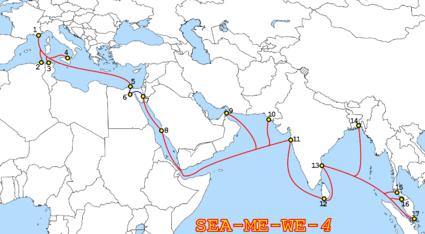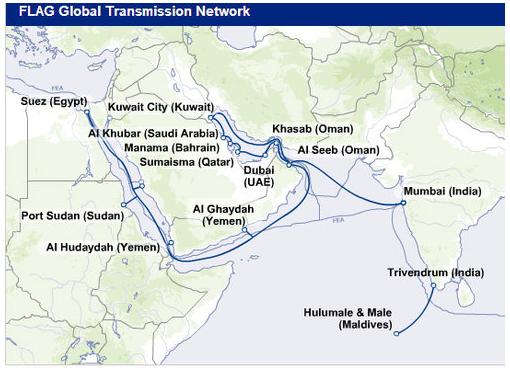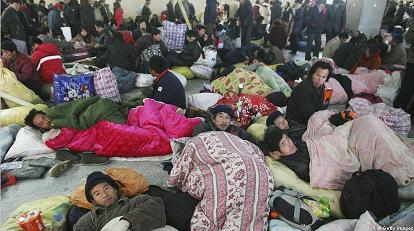Please do not reply to this Newsletter. You will likely get a response from a machine, not Nancy! For
feedback on the Newsletter or to correspond with Nancy, click here instead.
Alexandria Cable Breaks
On January 30, 2008 undersea internet cables connecting the Middle East with Europe were damaged,
breaking connections from as far away as India with Europe. The breaches appeared to be offshore by
about 5.2 miles from Alexandria, Egypt - cause unknown. It quickly became apparent that two different
cables had been damaged. The cables shared the same route, which stretched from France past
Palermo, Italy, thence down to Alexandria in Egypt.

- Severed Cables Disrupt Internet
January 31, 2008
http://news.bbc.co.uk/2/hi/technology/7218008.stm
- FLAG Telecoms operate the 17,400 mile long submarine communications cable.
SEA-ME-WE 4 is a submarine cable system linking South East Asia to Europe via the
Indian subcontinent and the Middle East. Neither of the cable operators have confirmed
the cause or location of the outage but some reports suggest it was caused by a ship's
anchor near the port of Alexandria in Egypt.
It was at first suspected that ships' anchors snagged the cables while the ships were being dragged by a
storm that beset the area earlier. But it is extremely rare for ships' anchors to damage more than one
cable at a time.
- Mediterranean Cables Cut, Disrupting Communications
January 30, 2008
http://www.bloomberg.com/apps/news?pid=20601085&sid=aWe706hsLNdY&refer=europe
- Six ships were diverted from Alexandria port and one may have severed the cables with an
anchor, said a spokesman for Flag Telecom Group Ltd., which operates one of the cables.
The incident took place 8.3 kilometers (5.2 miles) from Alexandria beach in northern
Egypt.
The Zeta reaction to this incident was to explain how plate movement, in particular the Arabian Plate,
caused the breach. As the Arabian Plate rotates in place, the Mediterranean cables are stretched at the
point where they approach landfall.
ZetaTalk Explanation 1/31/2008: We have spoken since the early days of ZetaTalk about the
stretch zones of the world, where plates are pulling apart. The Red Sea is one of these zones, as is
the African Rift, pulling apart as Africa rolls into the Indian Ocean. The Suez Canal is thus pulled
eastward, creating tension on any cables laid under the Mediterranean from France or Italy into
Egypt. These cables are laid with slack, and pressed into the seabed where expected to be
anywhere near where ships anchor. For a single cable to be damaged potentially by a ship
anchor might fly as an excuse, but two cables, simultaneously? The point of fault can be
estimated by the cable operators by a type of ping located at the point of injury. Both of the
damaged cables reached shore at Alexandria, with the injury estimated to have occurred 5.2
miles off the coast from Alexandria.
What kind of tension were these cables under at this point? One end was secured at the point of
landfall. Where the cable under the Mediterranean was free, it had drag, particularly as it
approached shore as it would be buried in the seabed at this point, to avoid injury by ships'
anchors. A cable under tension in this manner due to the plate separating/stretching would rise
up, and be a perfect target for an anchor. The ships whose anchors tore the cables were not
illegally anchored at the distance from shore where the injury occurred. Instead the cables were
unexpectedly above the floor of the seabed at that point, and vulnerable to being hooked by
anchors.
Will more such catastrophes occur in stretch zones? Broken communications are the least of
mankind's worry there. Chasms will open up. Roads will tear and bridges will drop. Buildings will
find their infrastructure shifting beneath them, and will either drop into their foundations or slip
sideways into a lean. Gas and water mains will continue to shatter, with fires and explosions
caused by gas leaks running rampant through neighborhoods or business districts. The stretch
has only begun, and will accelerate as the plates begin to move more aggressively.
Dubai Cable Breaks
Not days later on February 1, 2008 another undersea cable breach occurred, this one off the coast of
Dubai.
- Internet Provider in UAE Confirms Undersea Cable Cut Between Dubai, Oman, Cause
Unknown
February 2, 2008
http://www.iht.com/articles/ap/2008/02/02/africa/ME-GEN-Mideast-Internet-Outages.php
- An undersea cable had been cut in the Persian Gulf, causing severe phone line disruptions
and compounding an already existing Internet outage across large parts of the Middle East
and Asia after two other undersea cables were damaged earlier this week north of Egypt.
It was not known how the underwater FLAG FALCON cable, stretching between the
United Arab Emirates and Oman, had been damaged. Workers were still trying to
determine how the Persian Gulf cable was cut.
In addition to the breach offshore from Dubai on February 1, there were two other breaches nearby.
The major breach occurred between Dubai and Muscat, which lies to the SE of Dubai along the coast.
Another occurred to the NE of Dubai up toward Qatar on a cable managed by Q-tel. And a third
breach occurred where the cable loops up to Bandar Abbas on the coast of Iran across the straits from
Dubai.

- Ruptures Call Safety of Internet cables into Question
February 4, 2008
http://www.iht.com/articles/2008/02/04/technology/cables.php
- A cable operated by Qatar's Q-Tel, which linked Qatar to the United Arab Emirates
through the islands of Haloul and Das, was cut February 1. A spokesman for Q-Tel said
Qatar was operating at about 60 percent of telephone capacity Monday, but that Internet
and data transmission services were working at normal speed. Q-Tel will not know what
caused the Qatar-UAE Submarine Cable System rupture until it sends a repair ship to pull
the cable off the ocean floor.
-
- Cable Damage Hits 1.7m Internet Users in UAE
February 5, 2008
http://www.khaleejtimes.com/DisplayArticle.asp?
- A total of five cables being operated by two submarine cable operators have been
damaged with a fault in each. These are SeaMeWe-4 (South East Asia-Middle
East-Western Europe-4) near Penang, Malaysia, the FLAG Europe-Asia near Alexandria,
FLAG near the Dubai coast, FALCON near Bandar Abbas in Iran and SeaMeWe-4, also
near Alexandria.
Once again, the breaks occurred offshore where the cables make landfall, where tension in a stretched
cable would cause it to rise up out of the seabed. The Zetas point out that the tension along the cable
attached to land near Dubai was caused by the rotating Arabian Plate, as this creates tension in the cable
where it is stretched between India and Dubai when the "toe" of the boot is lowered.

ZetaTalk Explanation 2/2/2008: Once again an undersea internet cable is torn near where it
makes landfall. This incident is in Dubai, on the other side of the Arabian Plate from Alexandria.
What is similar in both of these incidents? Both are offshore from landfall sites, where the cable
rises out of the seabed to connect at a spot where it is fixed. Such a spot creates tension if the
cable is being stretched, causing the cable to rise up out of the seabed and reducing slack. This
causes the tense cable to be vulnerable to ships' anchors. The Flag Falcon was a new cable, laid
since early 2005 and thus plowed into the seabed properly and recently to avoid ships' anchors in
shallow water. If the breach offshore from Alexandria was due to the stretch zone in the
Mediterranean caused by the African continent rolling eastward and dropping into the Indian
Ocean, what caused this stretch offshore from Dubai?
After leaving Alexandria, the cables cross the Suez Canal to land on the east of the canal, thence
down the Red Sea to where it empties into the Indian Ocean, thence along the bottom of the
"boot" of the Arabian peninsula and up around the "toe" formed by Oman to landfall in Dubai.
As we have stated, the Arabian plate will rotate as this region of the world is pulled apart. As
though the "boot" were walking, it will move from where the "heel" appears to be landing to
where the "boot" is rolling to be positioned on its "toe". Where this does not put tension along a
cable laid around the edges of the "boot", it puts tension on the cable from another end - the
landfall in India and Pakistan. The "heel" of the boot has been pulled away from India and
Pakistan. Overall, the stretch zones around the Arabian Plate are pulling open, thus there is less
slack on any cables laid there.
This was a new cable, laid since 2005, so was well plowed into the seabed where it would be exposed
to ships' anchors. Ships' anchors are a perennial problem for buried cables, so the cables are plowed
into the seabed as the cable approaches shore.
- http://www.wired.com/wired/archive/4.12/ffglass_pr.html
- Anchors are a perennial problem that gets much worse during typhoons, because an
anchor that has dropped well away from a cable may be dragged across it as the ship is
pushed around by the wind. Formerly, cable was plowed into the bottom in water
shallower than 1,000 meters, which kept it away from the trawlers. Because of recent
changes in fishing practices, the figure has been boosted to 2,000 meters. But this means
that the old cables are still vulnerable.
-
- Saudi Arabia Confirms Multi-Million Dollar Investment in FALCON
May 7, 2005
http://www.ameinfo.com/59481.html
- FALCON, a new high-capacity resilient loop cable system is being installed to provide
multiple landings throughout the Gulf region, with submarine links stretching from the
Middle East to Egypt in the west and, initially, to India in the east.
China Ice Storm
Weather extremes combined with fuel shortages created a disaster in China, where hundreds of
thousands of travelers have been delayed and trapped at airports by ice and snow deposited by winter
storms.
- Snow Storm Brings China to a Halt
January 28, 2008
http://www.ft.com/cms/s/0/3ccaf42e-cdb1-11dc-9e4e-000077b07658.html
- China's transport and energy systems have been caught in a perfect winter storm, with
hundreds of thousands of people stranded during the peak travel season after train delays
caused by heavy snow and power failures. The power crisis, the worst in China for many
years, has been caused by an acute shortage of the supply of coal, the country's staple fuel.
Brownouts have affected about half of China's 31 provinces and regions. The problem has
been amplified by unseasonably large snowfalls in northern and central China. The
Chinese media estimated that 150,000 travelers were stuck on Monday at the main rail
station in Guangzhou, capital of southern Guangdong province, with hundreds of
thousands more expected in coming days.

The Zetas took the opportunity to compare this disaster to New Orleans after Hurricane Katrina, where
multiple problems descended on a populace with little relief in sight - a preview of the types of problems
to be expected as the Earth changes increase.
ZetaTalk Comparison 2/2/2008: As with Hurricane Katrina, this is a microcosm of what the pole
shift will bring. During Katrina, there was a lack of rescue, high winds and storm surge, an
inability to travel, the public forced to drink sewage polluted water, and broken communications.
The microcosm was possible, of course, because the hurricane developed in strength suddenly
and changed course, because New Orleans was a city below sea level, and because the Bush
administration proved incompetent in planning and facilitating a rescue. Nevertheless, this was
an example of what the public can expect. Most disasters are treatable as they are a single blow,
with rescue possible from regions not affected by the disaster. There may be an earthquake or a
flood or a hurricane or a drought with starvation or communication difficulties - but not all
occur at once.
During the recent China ice storm there was once again a microcosm of what the pole shift will
bring. Travel of any sort was halted. Communications were down so that people were trapped
away from home without a means to phone home. People were trapped for days without
adequate food and water - an unexpected emergency. And the situation did not resolve quickly,
as the ice storms were horrific, putting down a layer of ice that did not quickly melt. These types
of situations will be on the increase, such that emergency management teams are exhausted, as
we have predicted, and the public is left in distress.
You received this Newsletter because you subscribed to the ZetaTalk Newsletter service. If undesired, you can quickly
Unsubscribe.
|

